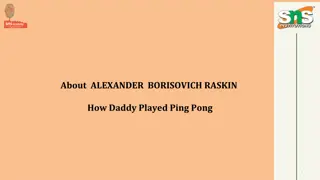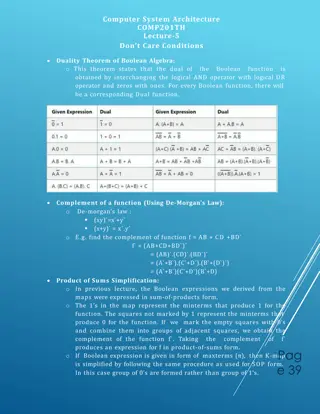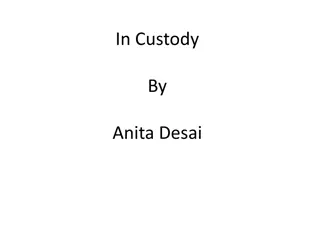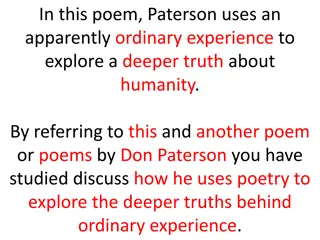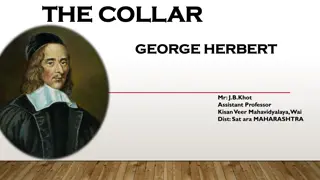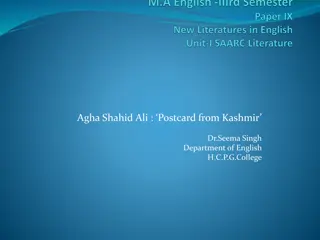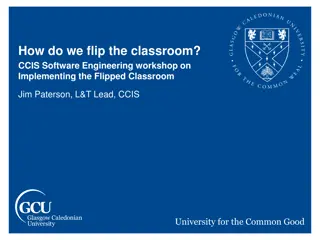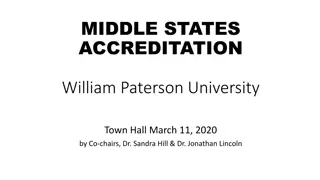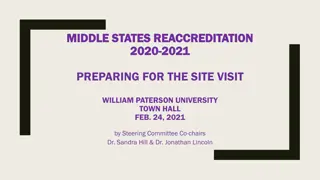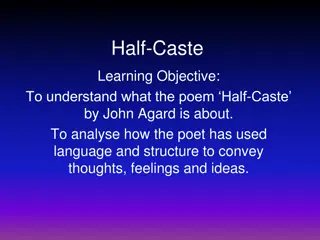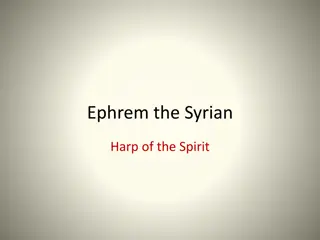Don Paterson: Poet and Musician
Don Paterson, a renowned poet and professional jazz musician, seamlessly blends musical qualities into his poems. His work showcases concentrated formal shapes, diverse psychological scenarios, and a fascination with science, offering readers a captivating exploration of different perspectives. Born in Dundee in 1963, Paterson has had a multifaceted career, transitioning from music to poetry and even journalism. His poetry collections have earned critical acclaim and numerous awards. With interests in linguistic and cognitive approaches to poetry and a background in music, Paterson's creative range is both unique and intriguing.
Download Presentation

Please find below an Image/Link to download the presentation.
The content on the website is provided AS IS for your information and personal use only. It may not be sold, licensed, or shared on other websites without obtaining consent from the author.If you encounter any issues during the download, it is possible that the publisher has removed the file from their server.
You are allowed to download the files provided on this website for personal or commercial use, subject to the condition that they are used lawfully. All files are the property of their respective owners.
The content on the website is provided AS IS for your information and personal use only. It may not be sold, licensed, or shared on other websites without obtaining consent from the author.
E N D
Presentation Transcript
Don Paterson is not just a fine poet but also an accomplished professional jazz musician Paterson s poems display numerous musical qualities as he finds no ideological conflict between the two artistic forms With their highly concentrated formal shapes, psychological scenarios and keen interest in science, Paterson poems might be read and appreciated as an intoxicating medley of registers and ways to see and experience the world
Don Paterson was born in Dundee in 1963 Although he has worked as a writer since the early nineties, he left school to pursue a career in music, and spent four years in Dundee playing the top-twenty hits of the era with club bands, while also working with local jazz acts He moved to London in 1984 -around this time he also began reading and writing poetry He returned to Scotland in '98 for a confused period in Edinburgh, during which he wrote a great deal of journalism, working as an arts columnist for Scotland on Sunday, and a video games reviewer for The Times He has worked in the School of English at the University of St Andrews since 2002, where he lectures full-time and holds the position of Professor of Poetry
His collections of poetry include Nil Nil (1993), God s Gift to Women (1997), The Eyes (a1999), Landing Light (2004), Orpheus (2006), Rain (2010), 40 Sonnets (2016), and Zonal (2020) His poetry has won a number of awards, including tthe T.S. Eliot Prize on two occasions He is a Fellow of the Royal Society of Literature and a Fellow of the English Association He received the OBE in 2008 and the Queen s Gold Medal for Poetry in 2010
He is interested in linguistic and cognitive scientific approaches to poetry, an interest widely reflected in his own poems, but also his reviews and commentaries (on Shakespeare s sonnets, for instance) As a musician, he began to concentrate on classical and twelve-string guitars in the late 1980s He still performs solo and in various ensembles with the pianist Steve Hamilton As an IT-expert, he has a keen interest in digital music technology and its creative use
Two Trees One morning, Don Miguel got out of bed with one idea rooted in his head: to graft his orange to his lemon tree. It took him the whole day to work them free, lay open their sides, and lash them tight. For twelve months, from the shame or from the fright they put forth nothing; but one day there appeared two lights in the dark leaves. Over the years the limbs would get themselves so tangled up each bough looked like it gave a double crop, and not one kid in the village didn t know the magic tree in Miguel s patio. The man who bought the house had had no dream so who can say what dark malicious whim led him to take his axe and split the bole along its fused seam, and then dig two holes. And no, they did not die from solitude; nor did their branches bear a sterile fruit; nor did their unhealed flanks weep every spring for those four yards that lost them everything as each strained on its shackled root to face the other s empty, intricate embrace. They were trees, and trees don t weep or ache or shout. And trees are all this poem is about.
Imperial Is it normal to get this wet? Baby, I'm frightened -- I covered her mouth with my own; she lay in my arms till the storm-window brightened and stood at our heads like a stone After months of jaw jaw, determined that neither win ground, or be handed the edge, we gave ourselves up, one to the other like prisoners over a bridge and no trade was ever so fair or so tender; so where was the flaw in the plan, the night we lay down on the flag of surrender and woke on the flag of Japan
The Scale of Intensity 1) Not felt. Smoke still rises vertically. In sensitive individuals, d j vu, mild amnesia. Sea like a mirror. 2) Detected by persons at rest or favourably placed, i.e. in upper floors, hammocks, cathedrals, etc. Leaves rustle. 3) Light sleepers wake. Glasses chink. Hairpins, paperclips display slight magnetic properties. Irritability. Vibration like passing of light trucks. 4) Small bells ring. Small increase in surface tension and viscosity of certain liquids. Domestic violence. Furniture overturned. 5) Heavy sleepers wake. Pendulum clocks stop. Public demonstrations. Large flags fly. Vibration like passing of heavy trucks. 6) Large bells ring. Bookburning. Aurora visible in daylight hours. Unprovoked assaults on strangers. Glassware broken. Loose tiles fly from roof.
7) Weak chimneys broken off at roofline. Waves on small ponds, water turbid with mud. Unprovoked assaults on neighbours. Large static charges built up on windows, mirrors, television screens. 8) Perceptible increase in weight of stationary objects: books, cups, pens heavy to lift. Fall of stucco and some masonry. Systematic rape of women and young girls. Sand craters. Cracks in wet ground. 9) Small trees uprooted. Bathwater drains in reverse vortex. Wholesale slaughter of religious and ethnic minorities. Conspicuous cracks in ground. Damage to reservoirs and underground pipelines. 10) Large trees uprooted. Measurable tide in puddles, teacups, etc. Torture and rape of small children. Irreparable damage to foundations. Rails bend. Sand shifts horizontally on beaches. 11) Standing impossible. Widespread self-mutilation. Corposant visible on pylons, lampposts, metal railings. Waves seen on ground surface. Most bridges destroyed. 12) Damage total. Movement of hour hand perceptible. Large rock masses displaced. Sea white.
Is Patersons musicianship registered in his texts? If so, how exactly? What are the limits of the analogy drawn by Two Trees ? Does the poem succeed in breaking those limits? How does the metrical and rhyming structure of Imperial affect the overall tone of the poem? Analyse the images Paterson uses in The Scale of Intensity . How do they define or re-define the concept of intensity? Is the world of Paterson s poetry introverted or rather extroverted? State your arguments.



